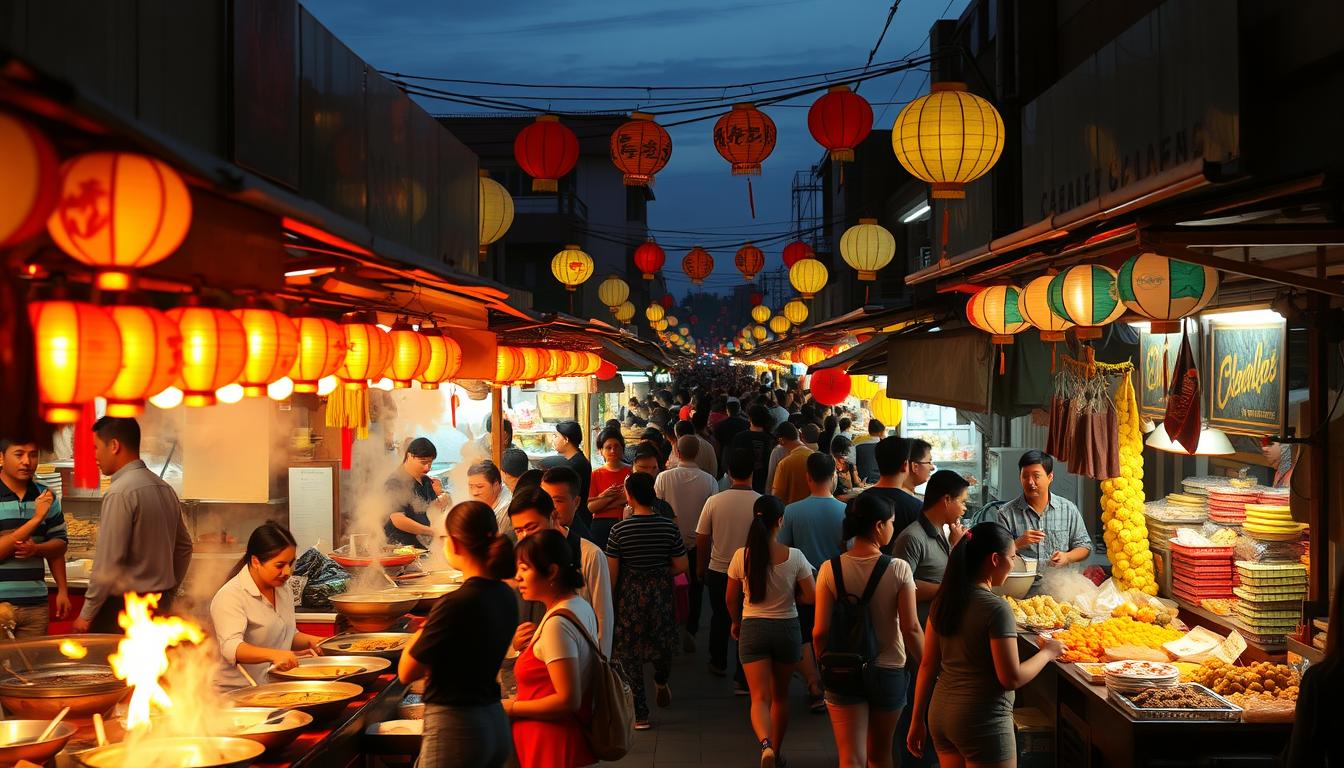Best Street Food Markets in Asia: A Culinary Adventure
Whether you’re a seasoned foodie or curious traveler, exploring these markets provides an unforgettable sensory journey that connects you with the heart and soul of Asian cultures. Join us as we uncover the most extraordinary street food markets across Asia, where unforgettable culinary adventures await around every corner.
The vibrant atmosphere of a typical Asian street food market
Thailand: The Street Food Capital
Thailand has earned its reputation as the street food capital of Asia, with markets that tantalize all senses. The country’s street food scene perfectly balances sweet, sour, spicy, and savory flavors that have made Thai cuisine famous worldwide.
Chatuchak Weekend Market, Bangkok
Spanning over 35 acres with more than 15,000 stalls, Chatuchak is one of the world’s largest markets and a food lover’s paradise. While known for shopping, its food section offers an incredible array of authentic Thai dishes. From spicy som tam (papaya salad) to creamy coconut ice cream served in coconut shells, the market provides endless culinary discoveries.
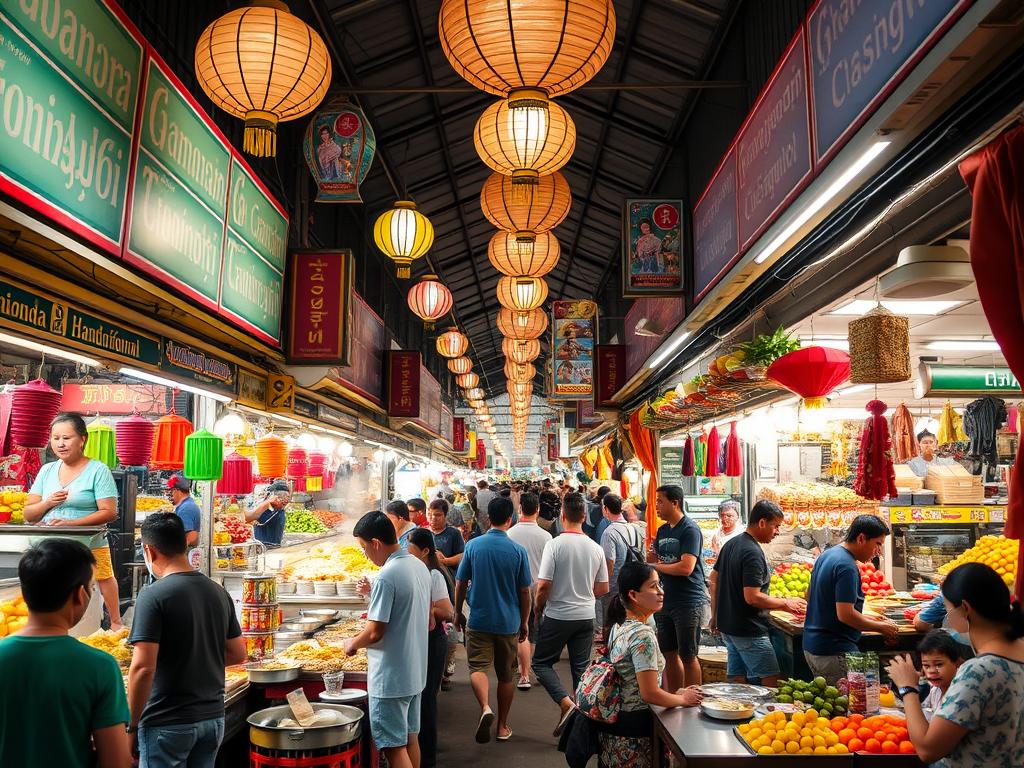
The vibrant food section at Chatuchak Weekend Market
Chiang Mai Night Bazaar
Northern Thailand’s cuisine shines at the Chiang Mai Night Bazaar, where specialties like khao soi (curry noodle soup) and sai oua (herb-filled sausage) showcase the region’s unique flavors. The market stretches along Chang Khlan Road, with food stalls clustered in courtyards and side streets, creating intimate dining spaces under the stars.
Experience Thailand’s Culinary Magic
Ready to taste authentic Thai street food? Our guided food tours take you to the best local spots with expert guides who explain each dish’s cultural significance.
Vietnam: Fresh Flavors and French Influence
Vietnamese street food markets showcase the country’s remarkable ability to blend fresh herbs, delicate flavors, and influences from its French colonial past. The result is a street food scene that’s both sophisticated and accessible.
Ben Thanh Market, Ho Chi Minh City
This iconic market in the heart of Ho Chi Minh City transforms from a daytime shopping destination to a vibrant food haven after sunset. The market’s food stalls serve classics like pho (noodle soup), banh mi (Vietnamese sandwich), and com tam (broken rice). The indoor section offers a cooler environment to enjoy these delicacies away from the tropical heat.
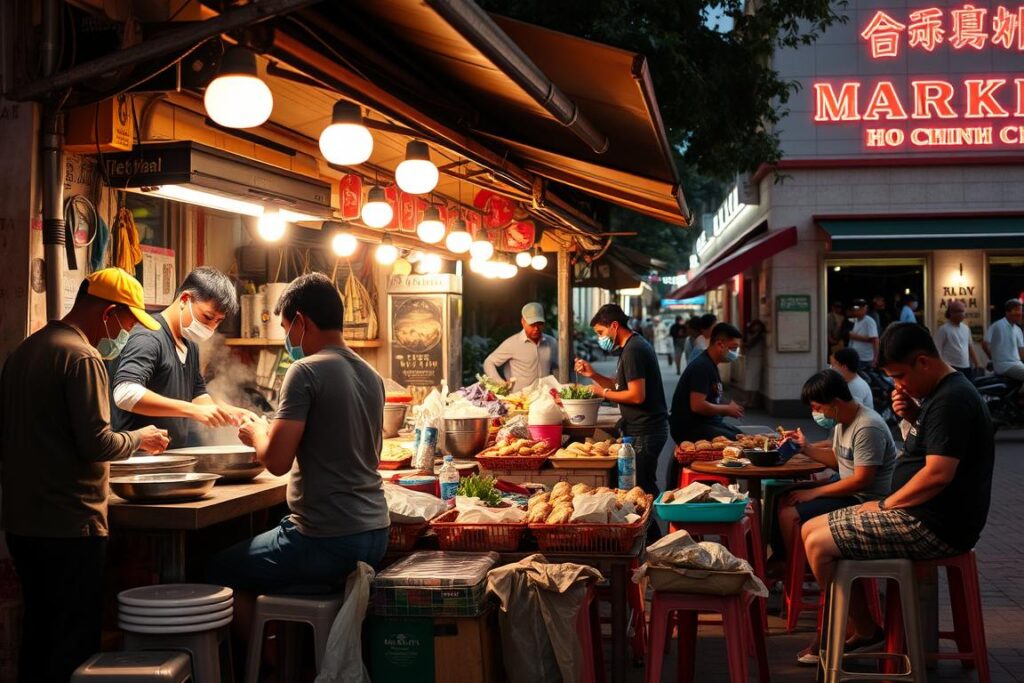
Evening food stalls at Ben Thanh Market serving authentic Vietnamese cuisine
Hanoi Night Market
Hanoi’s weekend night market in the Old Quarter offers specialties like bun cha (grilled pork with noodles) and egg coffee. The narrow streets fill with vendors and plastic stools, creating an intimate dining experience where you can watch skilled cooks prepare dishes that have been perfected over generations.
Japan: Precision and Tradition
Japanese street food markets reflect the country’s dedication to precision and quality. Even casual street foods are prepared with attention to detail and respect for ingredients that exemplifies Japanese culinary philosophy.
Nishiki Market, Kyoto
Known as “Kyoto’s Kitchen,” this covered market stretches across five blocks and has been serving locals for over 400 years. Specializing in Kyoto’s traditional foods, Nishiki offers everything from fresh seafood to pickled vegetables and Japanese sweets. Don’t miss trying tako tamago (baby octopus stuffed with a quail egg) or freshly grilled sembei (rice crackers).
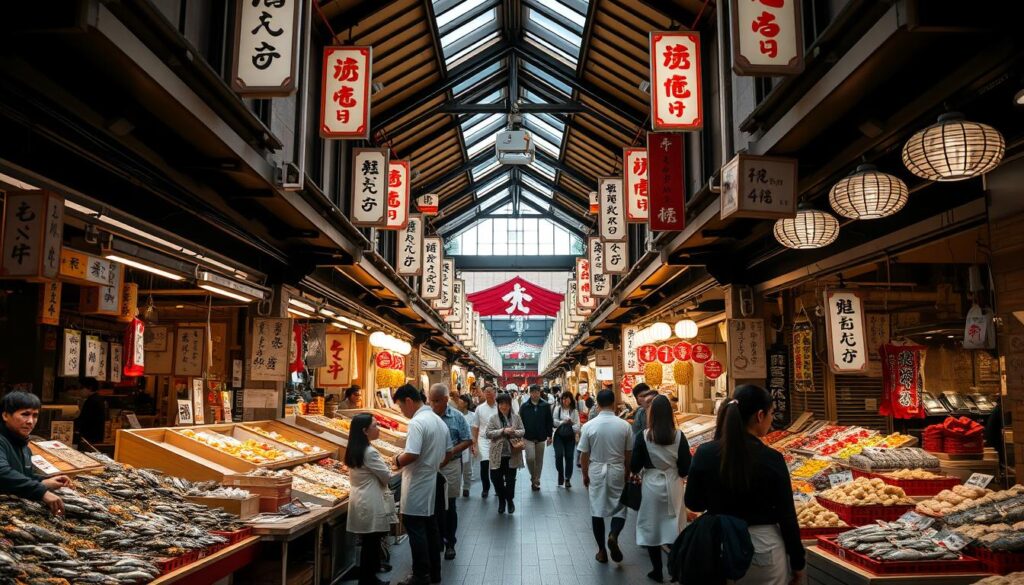
The historic Nishiki Market in Kyoto offering traditional Japanese delicacies
Ameya-Yokocho, Tokyo
This lively market under the train tracks between Ueno and Okachimachi stations began as a black market after World War II. Today, it’s a food lover’s paradise where you can sample takoyaki (octopus balls), yakitori (grilled chicken skewers), and taiyaki (fish-shaped cakes filled with sweet red bean paste).
Must-Try Japanese Street Foods
- Takoyaki – Savory octopus-filled balls topped with bonito flakes
- Okonomiyaki – Savory pancake with various toppings
- Taiyaki – Fish-shaped cake with sweet fillings
- Yakitori – Grilled chicken skewers
- Imagawayaki – Pancake filled with sweet red bean paste
Street Food Etiquette in Japan
- Eat at designated areas, not while walking
- Dispose of trash properly in designated bins
- Use provided chopsticks or utensils
- Queue patiently – no cutting in line
- Slurping noodles is acceptable and even appreciated
India: Spice and Diversity
India’s street food markets are as diverse as the country itself, with each region offering distinct flavors and specialties. Bold spices, complex flavor combinations, and centuries-old recipes make Indian street food an adventure for the senses.
Chandni Chowk, Delhi
One of India’s oldest and busiest markets, Chandni Chowk in Old Delhi is legendary for its street food. Paranthe Wali Gali, a narrow lane dedicated to paratha (stuffed flatbread), has shops dating back to the 1870s. Nearby, Jama Masjid area offers kebabs and biryani that showcase Mughlai influences on Indian cuisine.
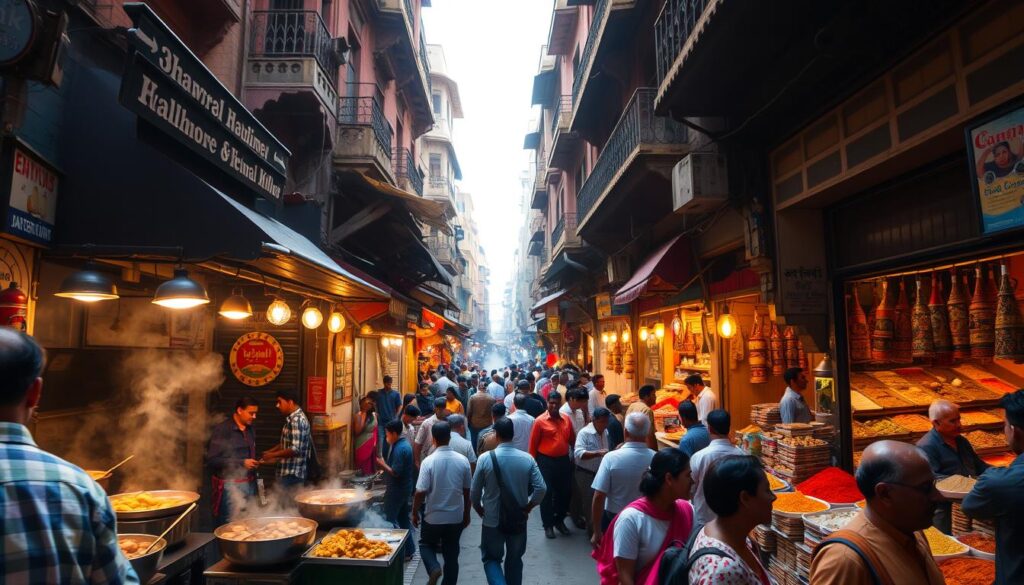
The historic lanes of Chandni Chowk filled with traditional street food vendors
Johari Bazaar, Jaipur
In the Pink City of Jaipur, Johari Bazaar offers Rajasthani specialties like pyaaz kachori (onion-filled pastry), ghewar (sweet disc-shaped cake), and lassi (yogurt drink). The market’s pink buildings provide a picturesque backdrop for culinary exploration in this historic city.
Taiwan: Night Market Culture
Taiwan has elevated night markets to an art form, with some markets featuring hundreds of stalls dedicated solely to food. These lively nighttime venues are central to Taiwanese social life and showcase the island’s unique culinary heritage.
Shilin Night Market, Taipei
Taiwan’s largest and most famous night market, Shilin offers an overwhelming variety of Taiwanese snacks. Must-tries include stinky tofu (despite its name, a beloved local delicacy), oyster omelets, bubble tea, and flame-grilled beef cubes. The market’s dedicated food court area provides seating where you can enjoy your culinary discoveries.
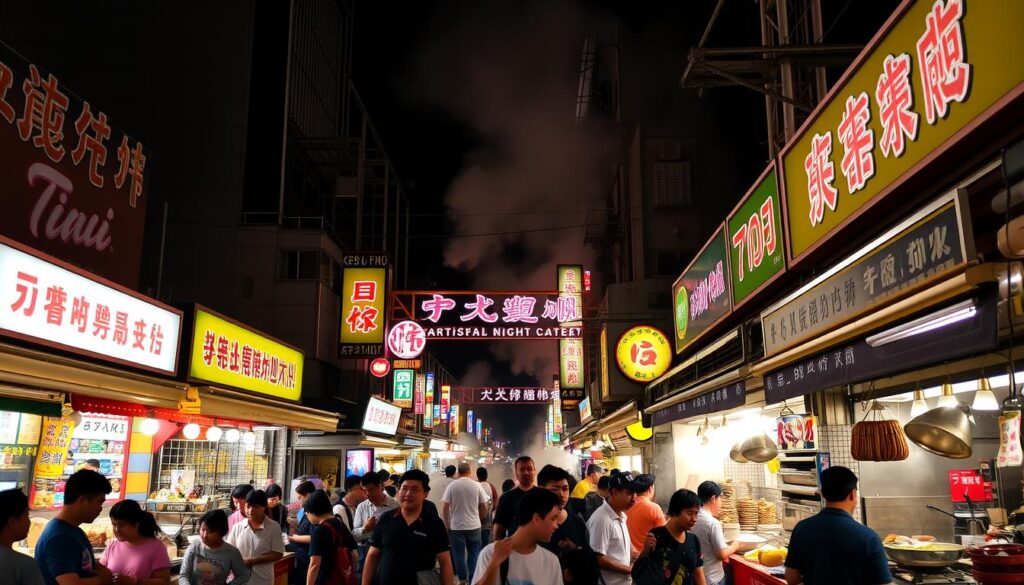
The vibrant atmosphere of Shilin Night Market after dark
Raohe Street Night Market
One of Taipei’s oldest night markets, Raohe Street is famous for its pepper buns (hújiāo bǐng) – pastries filled with pork and pepper baked in cylindrical ovens. The market’s entrance features an ornate temple, adding cultural significance to your culinary journey.
Discover Taiwan’s Night Market Magic
Our Taiwan food tours include expert guides who introduce you to hidden gems and explain the cultural significance behind each delicious bite.
Malaysia: Multicultural Flavors
Malaysia’s street food markets reflect the country’s diverse cultural makeup, blending Malay, Chinese, and Indian influences into a unique culinary landscape. This multicultural approach creates some of Asia’s most diverse and exciting street food scenes.
Jalan Alor, Kuala Lumpur
Once a red-light district, Jalan Alor has transformed into Kuala Lumpur’s most famous food street. As night falls, the street comes alive with stalls serving satay, wong ah wah (BBQ wings), and chilli crab. Plastic tables and chairs spill onto the street, creating a lively outdoor dining room under strings of red lanterns.
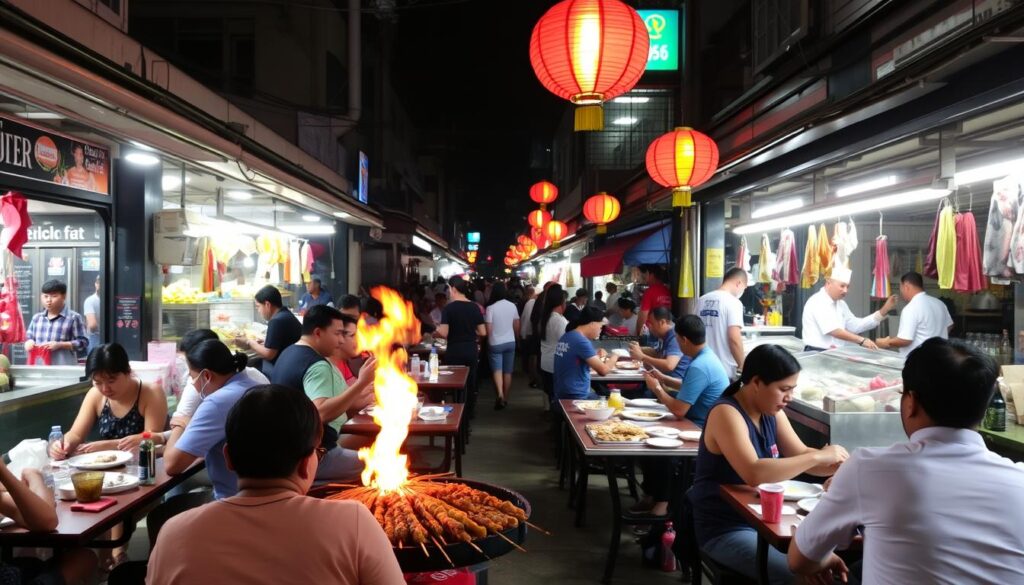
Evening dining at Jalan Alor food street in Kuala Lumpur
Gurney Drive, Penang
Penang is widely considered Malaysia’s food capital, and Gurney Drive is its culinary heart. This seafront hawker center offers char kway teow (stir-fried noodles), asam laksa (sour fish soup), and cendol (iced dessert with green jelly noodles). The sea breeze provides welcome relief as you sample these flavorful dishes.
South Korea: Traditional and Trendy
South Korean street food markets blend traditional recipes with modern innovations, creating a dynamic food scene that appeals to all ages. From centuries-old markets to trendy food streets, Korea offers diverse street food experiences.
Gwangjang Market, Seoul
One of Seoul’s oldest traditional markets, Gwangjang is renowned for its food alley where vendors specialize in particular dishes. The market is famous for bindaetteok (mung bean pancakes), mayak gimbap (seaweed rice rolls), and various types of tteokbokki (spicy rice cakes). Communal seating encourages interaction with locals as you enjoy these authentic dishes.
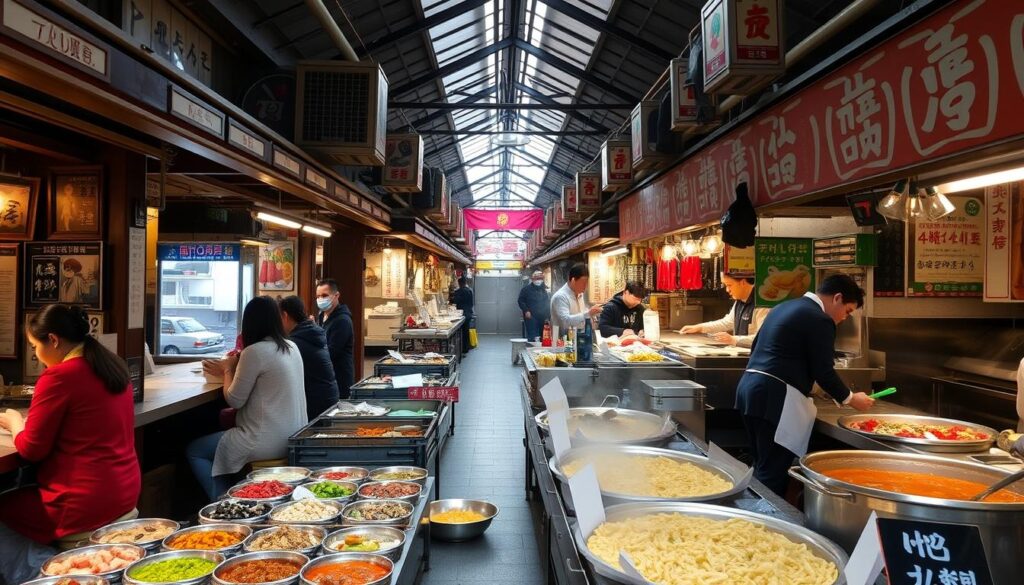
Traditional food vendors at historic Gwangjang Market
Namdaemun Market
Korea’s largest traditional market, Namdaemun offers affordable street food throughout its maze-like alleys. Don’t miss kalguksu (knife-cut noodle soup), hotteok (sweet filled pancakes), and galchi jorim (braised hairtail fish). The market operates day and night, making it accessible regardless of your schedule.
Essential Tips for Enjoying Street Food in Asia
Food Safety
- Choose busy stalls with high turnover
- Watch for clean preparation areas
- Ensure meat is thoroughly cooked
- Carry hand sanitizer or wet wipes
- Drink bottled water only
Cultural Etiquette
- Learn basic food-related phrases
- Observe local eating customs
- Use right hand for eating in India
- Don’t waste food – order small portions
- Respect queuing systems
Practical Tips
- Carry small bills in local currency
- Download translation apps
- Take food tours on your first day
- Bring your own reusable utensils
- Ask locals for recommendations
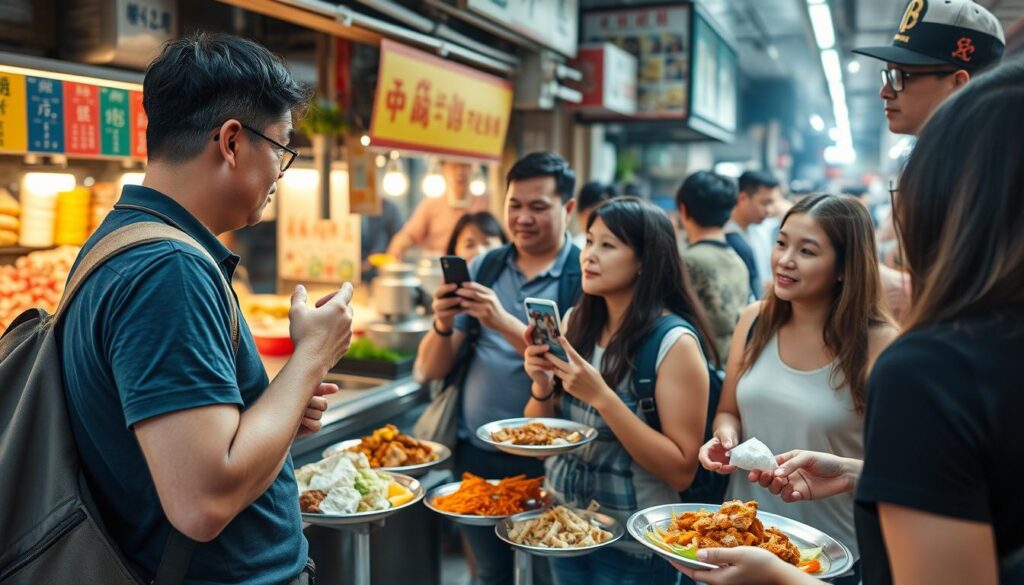
A guided food tour can help navigate the vast options at Asian street food markets
Best Times to Visit Street Food Markets in Asia
Timing your visit to Asia’s street food markets can significantly enhance your experience. Consider both seasonal factors and daily timing to make the most of your culinary adventures.
| Country | Best Season | Best Time of Day | Special Food Festivals |
| Thailand | November-February (cool season) | Evening (6pm-10pm) | Vegetarian Festival (October) |
| Vietnam | October-April (dry season) | Early morning (6am-8am) or evening | Tet Holiday (Lunar New Year) |
| Japan | March-May (cherry blossom) or Oct-Nov (autumn) | Lunchtime (11am-1pm) | Matsuri festivals (varies by region) |
| India | October-March (cooler months) | Evening (after 5pm) | Diwali (October/November) |
| Taiwan | October-April (less rainfall) | Night (7pm-midnight) | Ghost Festival (August) |
| Malaysia | June-August (drier period) | Evening (6pm-10pm) | Ramadan food bazaars |
| South Korea | April-June or Sept-Oct (mild weather) | Afternoon to evening | Seoul Bamdokkaebi Night Market |
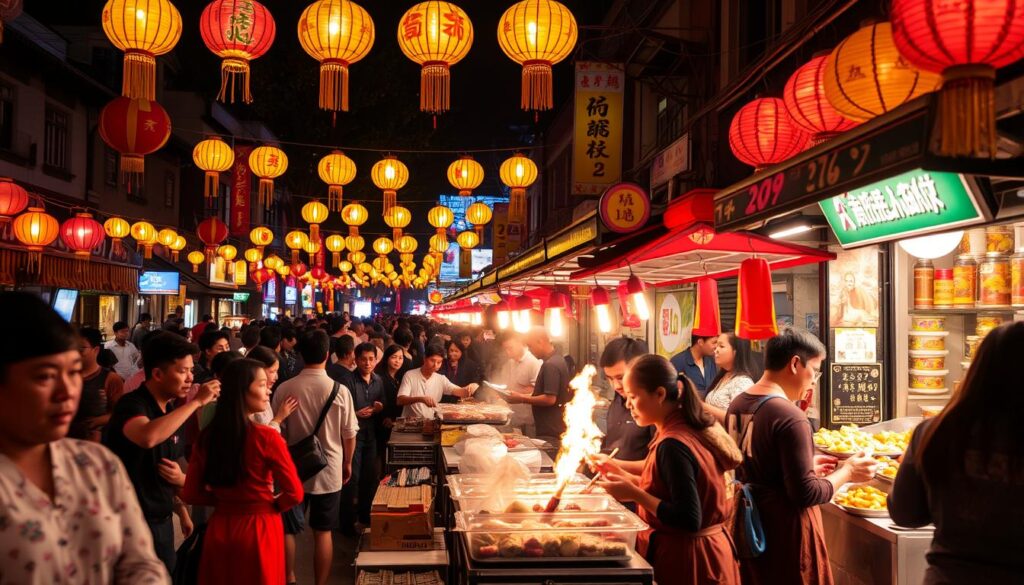
Seasonal festivals often feature special street food offerings
Frequently Asked Questions About Asian Street Food Markets
Is street food in Asia safe to eat?
Street food in Asia can be safe when you follow some basic precautions. Choose busy stalls with high customer turnover, ensure meat is thoroughly cooked, watch for clean preparation areas, and stick to freshly prepared hot foods. Many travelers enjoy street food without issues, but carrying medication for stomach upsets is always wise.
Which country has the best street food in Asia?
This is highly subjective and depends on personal taste preferences. Thailand, Vietnam, and Taiwan consistently rank high for their diverse and flavorful offerings. Thailand excels in bold flavors, Vietnam in fresh herbs and balanced dishes, and Taiwan in innovative night market snacks. The best approach is to try multiple countries and decide for yourself!
How much should I budget for street food in Asia?
Street food in Asia is generally very affordable. In most countries, you can enjoy a satisfying meal for -5 USD, with individual snacks often costing less than
Frequently Asked Questions About Asian Street Food Markets
Is street food in Asia safe to eat?
Street food in Asia can be safe when you follow some basic precautions. Choose busy stalls with high customer turnover, ensure meat is thoroughly cooked, watch for clean preparation areas, and stick to freshly prepared hot foods. Many travelers enjoy street food without issues, but carrying medication for stomach upsets is always wise.
Which country has the best street food in Asia?
This is highly subjective and depends on personal taste preferences. Thailand, Vietnam, and Taiwan consistently rank high for their diverse and flavorful offerings. Thailand excels in bold flavors, Vietnam in fresh herbs and balanced dishes, and Taiwan in innovative night market snacks. The best approach is to try multiple countries and decide for yourself!
How much should I budget for street food in Asia?
Street food in Asia is generally very affordable. In most countries, you can enjoy a satisfying meal for $2-5 USD, with individual snacks often costing less than $1. Japan tends to be more expensive, with street food items ranging from $3-8. Budget around $10-15 per day for a variety of street food experiences in most Asian countries.
What should I do if I have dietary restrictions?
Research key phrases to communicate your dietary needs in the local language. Carry translation cards explaining your restrictions. Vegetarians will find many options in India, Taiwan, and parts of China. For severe allergies, consider joining food tours with guides who can communicate with vendors. Buddhist vegetarian restaurants near temples often serve street food-style dishes without meat.
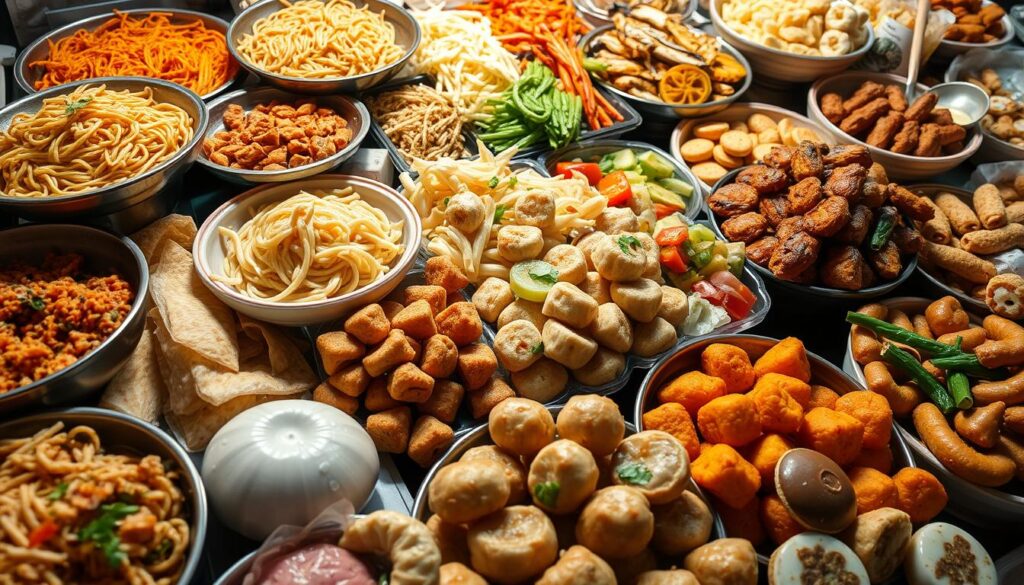
The incredible diversity of Asian street food offers something for every palate
. Japan tends to be more expensive, with street food items ranging from -8. Budget around -15 per day for a variety of street food experiences in most Asian countries.
What should I do if I have dietary restrictions?
Research key phrases to communicate your dietary needs in the local language. Carry translation cards explaining your restrictions. Vegetarians will find many options in India, Taiwan, and parts of China. For severe allergies, consider joining food tours with guides who can communicate with vendors. Buddhist vegetarian restaurants near temples often serve street food-style dishes without meat.

The incredible diversity of Asian street food offers something for every palate
Embark on Your Asian Street Food Adventure
Asia’s street food markets offer more than just delicious meals—they provide windows into authentic local cultures, traditions, and daily life. From the sizzling woks of Bangkok to the steaming pots of Seoul, these vibrant markets create unforgettable sensory experiences that connect travelers with the heart and soul of each destination.
Whether you’re planning your first Asian adventure or returning to explore new culinary territories, the street food markets of Asia promise rich rewards for curious travelers. Pack your appetite, bring an open mind, and prepare for a journey through some of the world’s most exciting flavors.
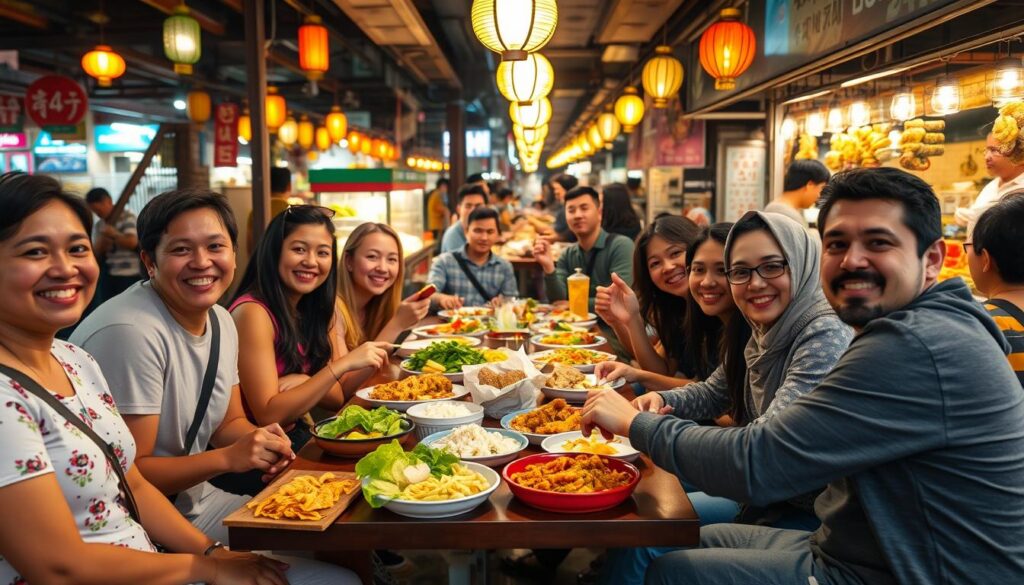
Sharing street food experiences creates lasting travel memories
Ready to Taste Asia’s Best Street Food?
Our specialized food tours take you beyond the tourist spots to authentic local markets with expert guides who speak the language and know the best vendors.

Sharon Molly is a content creator in lifestyle, fashion, and travel, delivering style-savvy advice and destination insights to inspire confident living. With a background in digital media, she combines aesthetics with practical guidance for modern women on the go.

